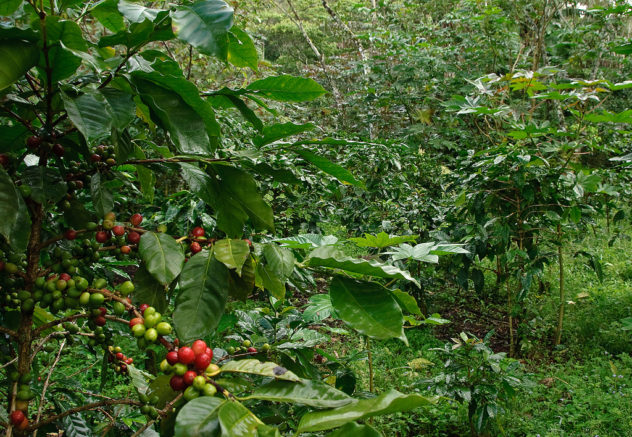The best kinds of coffee are grown in tropical climates with plenty of shade. However, major coffee producers clear cut forests to grow massive amounts of coffee all at once, despite the damaging effects of direct sunlight. Sourcing from small-scale farms that take the time and effort to grow their coffee in the shade will prove beneficial for the quality of the coffee you drink. Coffee plants thrive in the shade.
Types of Shade
Depending on the type of shade the coffee is grown in, the plants will grow differently. In rustic shade, which is the rarest and least-intensive shade-growing method, coffee shrubs are planted in an existing forest with the lowest strata of the forest removed to be replaced by with the coffee crop. In this way, there is not much alteration between the native plants. Often no pesticides or herbicides are used in this system, and it does not require as much maintenance.
Some coffee plants are grown in crop polyculture, so there are different types of plants and crop diversification where the coffee plants are grown. Canopy trees are often planted alongside the coffee shrubs to provide the much-needed shade. In other cases, shade crop monoculture — where only a single species of canopy trees provides shade — is used to grow a single type of coffee plant. For example, in Mexico, leguminous trees — trees that produce a lot of legumes — are grown specifically to provide shade for these coffee plants. In this monoculture, the coffee shrubs are planted closer together. Though monoculture typically implies growing large amounts of only one crop, shade-grown coffee is only successful when canopy trees are grown alongside them to provide the necessary shade.
Species Diversity
Shade-grown coffee is great for biotic environments. Tree and insect populations are bound to increase. Native and migratory birds have been recorded flocking to the coffee plantation in Soconusco in Chiapas, Mexico, and 46 of the 184 bird species were migratory. As few as six species were recorded with unshaded coffee monoculture. In a Guatemalan study of shade- versus sun-grown coffee, bird population and diversity had increased by 30% and 15% respectively. And in western India, 28 more species of mammals were found in shaded coffee plantations.
Benefits
Shaded coffee is often organically grown, so it is typically free of pesticides and healthier for you. It tastes better too — natural sugars increase as the coffee plants become accustomed to the shaded environment and the result is a coffee that tastes naturally sweeter. And because fewer chemicals are used, shaded coffee plantations help sustain the rain forests in which they’re grown.
We offer the best of what coffee has to offer in our shop from different coffee plantations all around the globe. Try our coffee out for yourself sometime, and if you have any questions, we’re experts when it comes to coffee.



